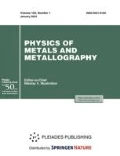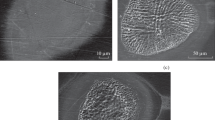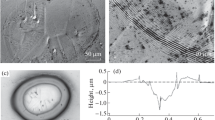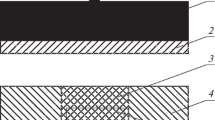Abstract
The effect of nanosecond UV laser pulses on copper and low-alloy copper samples has been studied. Traces of high-temperature deformation have been found at the energy density of 0.1–1 J/cm2 in the below-threshold regime without obvious traces of melting. They manifest themselves as the results of slipping and cracking along grain boundaries, as well as traces of crystallographic slip inside grains. The surface of the metal in the irradiated zone exhibits an uplift. The damage increases with the number of pulses. The height of the resulting uplift can reach 1 μm, and even more in some cases. The results obtained are similar to the electroplastic and magnetoplastic effects. By analogy, we propose to call the detected effect opticoplastic.
Similar content being viewed by others
INTRODUCTION
Lasers have existed for more than 60 years, and, all this time, their technological applications for material processing have been actively investigated alongside the physics and technology of laser sources [1, 2]. Continuous fiber and СО2 lasers typically employed for cutting, welding, hardening, and other metalworking processes are most commonly used. These lasers emit in the infrared range (IR) of the spectrum, but metals tend to reflect well in this region. To increase the technological productivity of the process, pulse-frequency emission and a reduced laser wavelength are often used. Increasing the pulsed power of radiation makes the treatment more effective. Femtosecond lasers have recently become very popular [3, 4]. However, they are still very expensive and difficult to operate. In contrast, cheaper nanosecond lasers are very effective and more practical in some cases [5–12].
To increase the fraction of laser energy absorbed in the material and thereby increase the efficiency of the process, emitters with shorter wavelengths have been created. The reflection coefficient of metals decreases noticeably with decreasing wavelength. Lasers emitting in the ultraviolet range have now been developed and manufactured. This radiation is absorbed by metals about ten times better than IR radiation. For example, copper, which reflects ~98% radiation in the infrared region, reflects only 10% at 355 nm [6]; i.e., the absorbed dose of radiation increases by a factor of 45.
Laser techniques used to create various nanostructures on the metal surface have been investigated in detail [10]. Surface structuring on the micron and submicron scale changes the radiative, electrical, electron-emissive, thermal, and adhesive properties of materials. It is known that the strength of metals and alloys can be increased together with their plasticity [13] and it is also possible that the electrical properties of the surface of conductors and dielectrics can be controlled [14].
In this work, we created nanostructures on the surface of copper and its alloys with a nanosecond pulsed-periodic UV laser. Nanosecond pulses of the UV laser can modify the metal surface, changing its properties dramatically [15–18]. This process assists in the diffusion welding of machined metal surfaces due to the intensification of diffusion processes in the metal surface layer [5, 7, 8]. Such works were made at the laser pulse energy density of the order of several J/cm2 in [5, 7, 8, 15–18]. The laser-induced breakdown effect is observed at this laser pulse energy density. This threshold phenomenon, which is the emergence of an erosive plasma torch near a sample, is accompanied by melting and evaporation of the material and the formation of a crater on the surface. This phenomenon was studied in detail when lasers appeared and described in detail in the literature [19].
This work was carried out at laser pulse energy densities lower than the laser-induced breakdown threshold (less than 1 J/cm2). Previously, below-threshold damage of the metal surface was reasonably considered insignificant in comparison to above-threshold craters. However, modern research techniques for studying the structure of irradiated samples provide an opportunity to examine these defects more closely. This paper reports on the before-threshold nano- and microeffects induced by nanosecond pulsed UV-laser radiation on the surface of the samples of copper and its alloys.
EXPERIMENTAL
The samples of oxygen-free M0b copper and its bronze low-alloyed Cu–Cr, Cu–Zr, and Cu–Cr–Zr alloys were prepared for the study. The alloying additives content in the alloys did not exceed 0.5%, which hardly affected the optical and thermophysical properties of the alloys, but significantly increased their mechanical properties [20, 21].
Samples 40 mm in diameter and 10 mm in thickness were fabricated and polished using standard optical techniques [22]. The reflection coefficients of the samples were preliminarily measured on a Cary-5000 UV-VIS-NIR spectrophotometer equipped with a UMA attachment. The samples reflected 10% at the operating wavelength λ = 355 nm. The samples were studied using a Zygo New View 7300 optical profilometer and JEOL JSM 6610LV scanning electron microscope (SEM) before and after laser irradiation. The figures in the paper are all obtained with a profilometer. The initial surface roughness of the samples in the area that was comparable to the laser spot area was approximately 15–20 nm.
The samples were then exposed to laser radiation. The experimental setup, optical scheme, and technique for processing the measurement results are described in detail in [5–7, 11, 17]. An Nd : YaG pulse-periodic laser (third harmonic) was used as a radiation source irradiating waves with a wavelength λ = 355 nm. The pulse energy was 8 mJ, the pulse duration was τ = 10 ns, and the frequency was f = 10 Hz. The number of pulses was controlled by an electromechanical shutter. A sample was mounted on a three-axis table that included two 8MT180 and one 8MT173 linear translators controlled by an 8SMC1-USBhF controller (Standa Ltd., Lithuania). The complex was controlled by a personal computer.
The laser beam was focused into a 100–200-μm spot onto a sample with a quartz lens with a focal distance of 250 mm. To determine the area of the irradiated zone on the sample surface, a series of below-threshold and above-threshold spots were recorded on each sample before experiments with above-threshold radiation. Each spot was exposed to 30 pulses of radiation with a specified energy density at a frequency of 10 Hz.
Laser pulse frequency f was chosen taking into account the capabilities of the laser used. We took into account the condition of complete cooling of the surface of copper or its alloy for the time between pulses, determined from Eq. (1) [23]:
where α is temperature conductivity, Tm is the melting temperature of copper or its alloy, and L is the thickness of the heated surface layer of copper or its alloy, determined from the equation
The surface cools down completely at f < 50 MHz, which is much higher than the f = 10 Hz used in the work.
RESULTS
The laser-induced breakdown threshold on the samples made of copper and its alloys in our experiment was observed at the energy density E ~ 1 J/cm2. Above this E, the surface was melted and evaporated. An erosive plasma torch appeared in the air near the surface, and a crater appeared in the sample. Figure 1a shows a laser crater framed by a ridge of molten material. Figure 1b shows a three-dimensional profile with a cross section, which was used to obtain a two-dimensional profile (Fig. 1c).
However, we observed below-threshold results of radiation exposure as early as at E ~ 0.1 J/cm2. The results were traces of high-temperature plastic deformation visible with a microscope. They represented the formation of uplift on the irradiated surface up to about 1 µm due to the migration of grain boundaries and crystallographic slip in the grain volume. There were almost no traces of molten metal in this case.
Typically, the resulting defects are irreversible. Some copper samples were examined after storage in a laboratory for 6 months. Their profilograms were the same.
Figure 2 shows electron microscopy images of the Cu–Cr–Zr sample surface damage after exposure to one (Fig. 2a), three (Fig. 2b), five (Fig. 2d), and thirty (Fig. 2e) laser pulses at E = 0.77 J/cm2. Their profilograms are shown below them.
There was an irregular uplift of the sample material in the laser spot region after exposure (Figs. 2–4). The height of the uplift increased and reached ~1 μm when the number of pulses and the energy density increased. This fact resulted in characteristic cracking along the grain boundaries. Some grains with a characteristic size of dozens of microns were as if squeezed out of the sample body to the surface.
Figure 3 shows a 3D image of the laser spot on the copper surface after exposure to 25 laser pulses. Figure 3b shows its 2D profilogram along the section shown in Fig. 3a. The surface in the spot rose to a height of up to 150 nm at the maximum point, and deep microcracks developed along the grain boundaries (up to 100 nm deep).
The damage grows with increasing E. The height of the uplifts increases up to 1 μm.
Figure 4 shows the data obtained from the Cu–Cr surface after exposure to 30 laser pulses: (a) an electron microscopy image of the damaged region, (b) a 3D image, and (c) a 2D profilogram.
Figure 5 presents a segment of the laser spot on the Cu–Cr surface after exposure to 30 pulses at E = 0.74 J/cm2. There are traces of the slip planes on the surface. They began to melt under the action of subsequent pulses.
DISCUSSION
The average laser power was low (at the level of several watts); therefore, this irradiation did not affect the geometry of the samples. However, the active exposure to the pulse component of radiation caused noticeable changes in the surface layers of the sample, without affecting its volume.
The absorption of light by metals occurs as a result of transferring energy from photons to electrons in the ~15-nm skin layer [24], which, in our case, significantly overheats the electron subsystem. The absorbed energy is transferred to the phonon subsystem during the electron–ion relaxation time (2–3 ps). The surface layer volume of the metal is heated during the time of the laser pulse action, i.e., 10 ns.
Qualitative estimates [6] performed using Eq. (3) and analysis of the electron microscopy images of copper and its alloys show that heating by a laser pulse at E ~ 0.6–1 J/cm2 allowed us to achieve a premelting temperature in copper near the surface layer.
The threshold energy density of melting, taking into account the specific melting heat, is [25]:
where δ(τ) carries the physical meaning of the effective thickness of the skin layer, where the absorbed energy of the laser pulse with duration τ is emitted in the material. Symbols ρ, С, Tm, Tin, and Lm are the density, specific heat capacity, melting temperature, initial temperature, and the heat of melting of the material, respectively. In the case of surface heating
We made qualitative estimates for copper using Eqs. (3) and (4) at С = 385 J/(kg K), ρ = 8920 kg/m3, α = 1.2 × 10–4 m2/s, Tm = 1356 K, Tin = 293 K, Lm = 204.7 × 103 J/kg [20], and τ = 10 ns. The following values were obtained: δ(τ) = 971 nm, Em(τ) = 0.59 J/cm2 (taking into account reflection). The results for the low-alloyed alloys used in this work are similar.
The electron microscopy images and profilograms show the traces of high-temperature deformation in the surface layer of copper and its low-alloyed alloys as a result of exposure to nanosecond UV-laser pulses.
Various pulse effects on plastic deformation of metals have been actively studied since the second half of the 20th century [26–29]. Exposure to electromagnetic fields excites the electronic subsystem. It transfers energy to the phonon subsystem to create a large number of short-wavelength phonons. They affect the structural defects (point, linear, grain boundaries, different precipitated phases) of the crystal lattice to facilitate the movement and redistribution of the crystal lattice defects. Of course, these microprocesses finally develop into macroprocesses of plastic deformation.
Thus, electroplastic [26] and magnetoplastic [27, 28] effects were discovered. The acoustoplastic effect has a similar effect [29].
Similar effects have also been occasionally observed when exposed to high-intensity laser radiation [30–34]. However, these results are not systematic. They were obtained using lasers that were very different from each other in wavelength, pulse duration, and energy density. This can be explained by the fact that when studying the effects of the laser pulse on solids, the main attention was paid to the much more spectacular and evident processes of melting and evaporation, largely masking the effects of laser pulses on plastic deformation [19].
There are interesting theoretical studies of Mirzadeh about “nonlinear strain waves interacting with laser-induced carriers of the local disorder,” summarized in Chapter 7 of the collective monograph [1]. These results, unfortunately, have not been properly confirmed by experimental studies so far.
Rather detailed studies of the effect of nanosecond UV laser pulses on plastic deformation that took place in the surface layer of copper and its low-alloyed alloys were carried out in [6, 35, 36]. They are summarized and analyzed in this work. The results allow us to conclude that we are dealing in this case with processes similar to the electroplastic and magnetoplastic effects and, by analogy, we think it fair to call the detected effect opticoplastic.
CONCLUSIONS
The laser-induced breakdown threshold in our experiment was ~1.0 J/cm2 for the samples of copper and its low-alloy alloys exposed to nanosecond UV-laser pulses. An erosive plasma torch appeared in the air, near the surface of the sample, and a crater with obvious traces of melting and evaporation of the metal appeared in the sample.
Traces of high-temperature deformation were found in the below-threshold regime without obvious traces of melting. They manifest themselves as the results of slipping and cracking along the grain boundaries, as well as traces of crystallographic slip inside the grains. The surface of the metal in the irradiated zone exhibits an uplift. The damage increases with the number of pulses. The height of the resulting uplift can reach 1 μm, and even more in some cases.
The results obtained are similar to the electroplastic and magnetoplastic effects. By analogy, we propose to call the detected effect opticoplastic.
REFERENCES
V. Ya. Panchenko, Laser Technologies for Material Processing: Modern Problems of Fundamental Research and Applied Development (FIZMATLIT, Moscow, 2009) [in Russian].
A. G. Grigor’yants and A. I. Misyurov, Technological Processes of Laser Treatment (MSTU after N. E. Bauman, Moscow, 2006) [in Russian].
S. I. Ashitkov, P. S. Komarov, A. V. Ovchinnikov, E. V. Struleva, V. V. Zhakhovskii, N. A. Inogamov, and M. B. Agranat, “Ablation and nanostructuring of metals by femtosecond laser pulses,” Quantum Electron. 44, No. 6, 535–539 (2014).
S. I. Ashitkov, S. A. Romashevskii, P. S. Komarov, A. A. Burmistrov, V. V. Zhakhovskii, N. A. Inogamov, and M. B. Agranat, “Formation of nanostructures under femtosecond laser ablation of metals,” Quantum Electron. 45, No. 6, 547–550 (2015).
V. N. Elkin, T. V. Malinskii, Yu. V. Khomich, and V. A. Yamshchikov, “Modification of the surface microtopography of a bronze alloy under irradiation with a scanning beam of nanosecond laser radiation pulses,” Inorg. Mater.: Appl. Res. 10, No. 3, 589–603 (2020).
T. V. Malinskii, S. I. Mikolutskii, V. E. Rogalin, V. Yu. Khomich, V. A. Yamshchikov, I. A. Kaplunov, and A. I. Ivanova, “Plastic deformation of copper under the action of high-power nanosecond UV laser pulse,” Tech. Phys. Lett. 46, 831–834 (2020).
Yu. A. Vashukov, S. F. Demichev, V. D. Elenev, T. V. Malinskii, S. I. Mikolutskii, Yu. V. Khomich, and V. A. Yamshchikov, “Laser processing of metal alloys for diffusion welding,” Prikl. Fiz., No. 1, 82–87 (2019).
Yu. V. Khomich and V. A. Yamshchikov, “The effect of preliminary laser surface treatment on the mechanical properties of a solid-phase compound of an iron-nickel alloy in diffusion welding,” Chapter 6. Advanced Materials. Proceedings of the International conference on Physics and Mechanics of New Materials and Their Applications. PHENMA (2019), pp. 61–71.
D. V. Ganin, S. I. Mikolutskiy, V. N. Tokarev, V. Yu. Khomich, V. A. Shmakov, and V. A. Yamshchikov, “Formation of micron and submicron structures on a zirconium oxide surface exposed to nanosecond laser radiation,” Quantum Electron. 44, No. 4, 317–321 (2014).
V. Yu. Khomich and V. A. Shmakov, “Mechanisms of direct laser nanostructuring of materials,” Phys.-Usp. 58, 455–465 (2015).
V. Yu. Khomich, Yu. M. Urlichich, V. A. Shmakov, V. N. Tokarev, A. M. Galstyan, S. Mikolutskiy, T. V. Malinskiy, and D. V. Ganin, “Formation of submicron structures on the surface of zirconium dioxide under illumination of nanosecond laser,” Inorg. Mater.: Appl. Res. 4, No. 3, 201–204 (2013).
S. I. Mikolutskii and Yu. V. Khomich, “Effect of nanosecond ultraviolet laser radiation on the structure and adhesion properties of metals and alloys,” Phys. Met. Metallogr. 122, No. 2, 148–153 (2021).
I. Matsui, T. Kawakatsu, Y. Takigawa, T. Uesugi, and K. Higashi, “Fabrication of bulk nanocrystalline Fe‒Ni alloys with high strength and high ductility by an electrodeposition,” Mater. Lett. 116, 71–74 (2014).
L. Lu, Y. Shen, X. Chen, L. Qian, and K. Lu, “Ultrahigh strength and high electrical conductivity in copper,” Science 304, 422–426 (2004).
F. Fraggelakis, G. Mincuzzi, I. Manek-Hönninger, J. Lopez, and R. Klinga, “Generation of micro- and nanomorphologies on a stainless steel surface irradiated with 257 nm femtosecond laser pulses,” RSC Adv. 8, 16082–16087 (2018).
T. Csizmadia, T. Smausz, C. Tápai, J. Kopniczky, X. Wang, M. Ehrhardt, P. Lorenz, K. Zimmer, L. Orosz, E. Varga, A. Oszkó, and B. Hopp, “Comparison of the production of nanostructures on bulk metal samples by picoseconds laser ablation at two wavelengths for the fabrication of low-reflective surfaces,” J. Laser Micro/Nanoeng. 10, No. 2, 110–118 (2015).
Yu. A. Zheleznov, T. V. Malinskii, S. I. Mikolutskii, R. R. Khasaya, Yu. V. Khomich, and V. A. Yamshchikov, “Titanium surface treatment with nanosecond laser radiation,” Pis’ma Mater. 4, No. 1, 45–48 (2014).
F. Luo, W. Ong, Y. Guan, F. Li, S. Sun, G. C. Lim, and M. Hong, “Study of micro/nanostructures formed by a nanosecond laser in gaseous environments for stainless steel surface coloring,” Appl. Surf. Sci. 328, 405–409 (2015).
S. I. Anisimov, Ya. A. Imas, G. S. Romanov, and Yu. V. Khodyko, Effect of High-Power Radiation on Metals (Nauka, Moscow, 1970).
A. K. Nikolaev and S. A. Kostin, Effect of High-Power Radiation on Metals (Nauka, Moscow, 1970).
O. E. Osintsev and V. N. Fedorov, Copper and Copper Alloys. Domestic and Foreign Brands. Domestic and Foreign Brands. Directory (Mashinostroenie, Moscow, 2004) [in Russian].
M. A. Okatov, Handbook of Technologist-Optical Engineer (Politekhnika, St. Petersburg, 2004) [in Russian].
M. N. Libenson, E. B. Yakovlev, and G. D. Shandybina, “Interaction of laser radiation with matter (power optics),” Lecture Notes Edited by V. P. Veiko. Part I. Absorption of Laser Radiation in Matter (ITMO, St. Petersburg, 2008) [in Russian].
A. V. Sokolov, Optical Properties of Metals (Fizmatlit, Moscow, 1961) [in Russian].
V. N. Tokarev, E. A. Cheshev, T. V. Malinskii, Yu. V. Khomich, V. A. Yamshchikov, Yu. A. Zheleznov, V. V. Bezotosnyi, and V. G. Artemov, “Elimination of undesirable effect of plasma melting side walls in laser drilling deep keyholes,” Usp. Prikl. Fiz. 1, No. 6, 686–691 (2013).
V. I. Spitsyn and O. A. Troitskii, Electroplastic Deformation of Metals (Nauka, Moscow, 1985) [in Russian].
V. I. Karas’ and V. I. Sokolenko, “Nonequilibrium kinetics of the electron-phonon subsystem can give rise to electric- and magnetic-plasticity effects in crystals in alternating electric and/or magnetic fields,” Phys.-Usp. 61, No. 11, 1051–1071 (2018).
I. M. Neklyudov, Ya. D. Starodubov, and V. I. Sokolenko, “The influence of magnetic fields on the resistance to plastic deformation of crystalline bodies,” Ukr. Fiz. Zh. 50, No. 8A, A113–A121 (2005).
N. A. Tyapunina, E. K. Naimi, and G. M. Zinenkova, Action of Ultrasound on Crystals with Defects (MSU, Moscow, 1999) [in Russian].
R. E. Rovinskii, V. E. Rogalin, V. M. Rozenberg, and M. D. Teplitskii, “Change in the structure of a copper-chromium alloy irradiated by a pulse of CO2 laser,” Fiz. i Khim. Obrab. Mater., No. 3, 7–11 (1980).
M. E. Gurevich, L. N. Larikov, V. F. Mazanko, A. E. Pogorelov, and V. M. Fal’chenko, “Influence of multiple laser action on mass transfer in metals,” Metallofiz. B 73, 80–83 (1978).
V. E. Rogalin, “Optical resistance of copper mirrors for high-power pulsed TEA CO2 lasers,” Materialovedenie, No. 9, 34–42 (2013).
K. Vegel and P. Beckland, “Application of electron and optical microscopy in studying laser-irradiated metal surfaces,” Appl. Phys. 36, 3697 (1965).
S. V. Vasil’ev, A. Yu. Ivanov, and V. A. Liopo, “Changes in the crystal structure of metals under laser radiation,” J. Eng. Phys. Thermophys. 80, No. 5, 857–863 (2007).
Yu. Khomich, T. Malinskiy, V. Rogalin, I. Kaplunov, and A. Ivanova, “Features of microrelief formation during laser treatment of Cu–Cr–Zr alloy surface for diffusion welding,” IOP Conf. Ser.: Mater. Sci. Eng. 939, 012035 (2020).
Yu. V. Khomich, T. V. Malinskiy, S. I. Mikolutskiy, V. E. Rogalin, V. A. Yamshchikov, I. A. Kaplunov, and A. I. Ivanova, “Powerful ultraviolet laser pulse impact on polished metals and semiconductors,” J. Phys.: Conf. Ser. 1697, 012254 (2020).
ACKNOWLEDGMENTS
We thank V.Y. Khomich, a member of the Russian Academy of Sciences, for helpful discussions, I.A. Kaplunov and A.I. Ivanova for conducting the electron microscopic study. We thank the Interdepartmental Laboratory of Semiconductor Materials and Dielectrics, National University of Science and Technology MISiS, for measurements of the reflection coefficients of the samples. The resources of the Center for Collective Use of Tver State University were used.
Funding
This work was performed within the state assignment, no. 0057-2019-0005.
Author information
Authors and Affiliations
Corresponding author
Ethics declarations
The authors declare that they have no conflicts of interest.
Additional information
Translated by T. Gapontseva
Rights and permissions
Open Access. This article is licensed under a Creative Commons Attribution 4.0 International License, which permits use, sharing, adaptation, distribution and reproduction in any medium or format, as long as you give appropriate credit to the original author(s) and the source, provide a link to the Creative Commons licence, and indicate if changes were made. The images or other third party material in this article are included in the article’s Creative Commons licence, unless indicated otherwise in a credit line to the material. If material is not included in the article's Creative Commons licence and your intended use is not permitted by statutory regulation or exceeds the permitted use, you will need to obtain permission directly from the copyright holder. To view a copy of this licence, visit http://creativecommons.org/licenses/by/4.0/.
About this article
Cite this article
Malinskii, T.V., Rogalin, V.E. & Yamshchikov, V.A. Plastic Deformation of Copper and Its Alloys under the Action of Nanosecond UV Laser Pulse. Phys. Metals Metallogr. 123, 178–185 (2022). https://doi.org/10.1134/S0031918X22020077
Received:
Revised:
Accepted:
Published:
Issue Date:
DOI: https://doi.org/10.1134/S0031918X22020077









